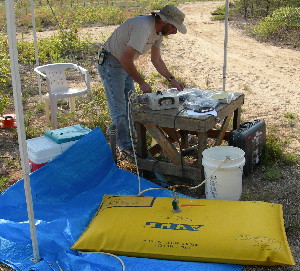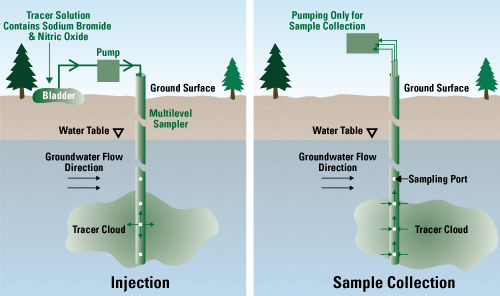Measuring How Nitrogen Transforms in Groundwater
 A USGS scientist prepares a tracer solution in a gas-tight bladder that will be pumped into a zone of nitrate-containing groundwater to monitor the production and consumption of nitric oxide dissolved in groundwater.
A USGS scientist prepares a tracer solution in a gas-tight bladder that will be pumped into a zone of nitrate-containing groundwater to monitor the production and consumption of nitric oxide dissolved in groundwater.
(Larger version)
Nitrogen contamination of groundwater from wastewater disposal is a growing problem worldwide. Too much nitrogen as nitrate in groundwater used for drinking water can be harmful to infants. U.S. Geological Survey (USGS) scientists and their colleagues have developed a new method to measure the rates at which inorganic nitrogen compounds, such as nitrate and nitrite, transform in groundwater. The new method can help water-resource managers, scientists, and others study the cycling of nitrogen in groundwater and the fate and natural removal of nitrogen from groundwater impacted by wastewater disposal.
The method is very sensitive to small changes and involves measuring trace concentrations of nitric oxide in groundwater. Nitric oxide is a very reactive intermediate product of denitrification and nitrification in groundwater when oxygen concentrations are low, a fact that makes it hard to measure. Denitrification and nitrification are important steps in the global nitrogen cycle. The scientists' article in Environmental Science and Technology documents the new method, which involves the injection and subsequent withdrawal of a solution of dissolved nitric oxide gas and a non-reactive tracer, such as sodium bromide, into the subsurface. The scientists monitor the resultant plume of tracer solution by withdrawing groundwater samples from multiple subsurface sampling ports (see diagram). The groundwater samples are analyzed and transformation rates for different forms of inorganic nitrogen (nitrate and nitrite) are determined. The ability to accurately measure nitric
oxide enables estimation of the rates of denitrification (in which the oxygen atoms of nitrate are removed to produce nitrogen gas) and of natural removal of
nitrate contamination in the subsurface. This study was funded by the USGS Toxic Substances Hydrology and Hydrologic Research and Development Programs. The scientists that conducted this study are part of a larger team studying the fate of nutrients, such as nitrogen, and other contaminants in a groundwater contaminant plume on Cape Cod, Massachusetts.

Single-well tracer tests involve injecting a tracer solution into one port of a multilevel sampling well, creating a tracer cloud in the groundwater, and then monitoring the water chemistry in the tracer cloud from the same well as the tracer cloud moves away from the well.
( Larger version)
References
Smith, R.L., and Yoshinari, T., 2008, Occurrence and turnover of nitric oxide in a nitrogen-impacted sand and gravel aquifer: Environmental Science and Technology, v. 42, no. 22, p. 8,245-8,251, doi:10.1021/es801290v.
More Information
Related Headlines
Back to Headlines page
|

|